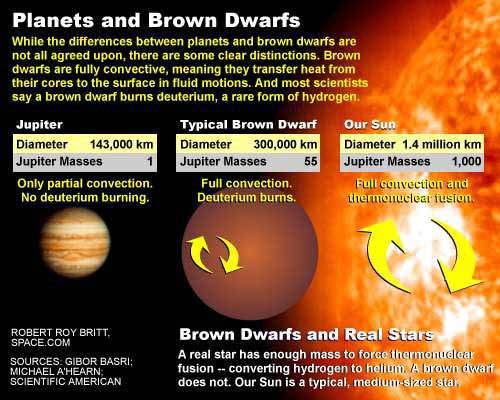Missing Link Between Planets and Stars Found

Browndwarfs are the oddballs of the cosmos, more massive than planets but not heavyenough to generate the thermonuclear fusion that powers real stars. Nowastronomers have found the coldest brown dwarf to date.
The failedstar might represent a new class of objects that are a missing link betweenplanets and stars.
The coldbrown dwarf floats freely in space, not bound to a star. Its mass is somewherebetween 15 and 30 times that of Jupiter. And it is about 660 degrees Fahrenheit(350 Celsius), cooler than any other known object in its class.
The surfaceof the sun is about 11,000 degrees F (6,000 degrees C). The temperature at the top of Jupiter's clouds is about -230 degrees F(-145 degrees C), though at its core the mercury soars to 43,000 degrees F(24,000 degrees C).
Thebrown dwarf, named CFBDS J005910.83-011401.3, is about 40 light-years from oursolar system. It was found by an international team using the Canada-France-Hawaii Telescope and Gemini North Telescope, both located in Hawaii, and the aEuropean Southern Observatory telescope in Chile.
Oddballs
Themass of brown dwarfs is usually less than 70 Jupiter masses. In contrast to astar like our sun, which spends most of its lifetime burning hydrogen andkeeping a constant internal temperature, a brown dwarf spends its lifetimegetting colder and colder.
Breaking space news, the latest updates on rocket launches, skywatching events and more!
Thefirstbrown dwarfs were detected in 1995. Since then, they have been found toshare common properties with giant planets, while differences remain. Forexample, clouds of dust and aerosols, as well as large amounts of methane, weredetected in the atmospheres of the coolest brown dwarfs, just as in theatmosphere of Jupiter and Saturn.
However,there were still two major differences. In the brown dwarf atmospheres, wateris always in gaseous state, while it condenses into water ice in giant planets;and ammonia has never been detected in the brown dwarf, while it is a majorcomponent from Jupiter's atmosphere.
Cooler still
Thenewly-discovered brown dwarf looks much more like a giantplanet than the known classes of brown dwarfs, both because of its lowtemperature and because of the presence of ammonia.
Todate, two classes of brown dwarfs have been known: the L dwarfs (temperature of2,100 to 3,600 Fahrenheit (1,200-2,000 C), which have clouds of dust andaerosols in their high atmosphere, and the T dwarfs (temperature lower than2,100 F), which have a very different spectrum because of methane forming intheir atmosphere.
Becauseit contains ammonia and has a much lower temperature than do L and T dwarfs,CFBDS0059 might be the protoype of a new class of brown dwarfs to be called theY dwarfs, the researchers propose. This new class would become the coldeststellar objects, hence the missing link toward giant planets.
Almost a planet
Thisdiscovery also has important implications in the study of extrasolar planets.
Theatmosphereof brown dwarfs looks very much like that of giant planets, therefore thesame models are used to reproduce their physical conditions. Such modelingrequires to be constrained with observations. Observing the atmospheres ofextrasolar planets is indeed very hard because the light from the planets isembedded in the much stronger light from their parent star. Because browndwarfs are sometimes isolated bodies, with no stars nearby, they are mucheasier to observe.
Solooking to browndwarfs with a temperature close to that of the giant planets will help inconstraining the models of extrasolar planets' atmospheres, the researcherssaid.
Thediscovery, led by researchers at Observatoire de Grenoble in France, the Canada-France-Hawaii Telescope, the University of Ottawa and other institutions willbe detailed in the journal Astronomy & Astrophysics.
- Top 10 Star Mysteries
- The Strangest Things in Space
- VIDEO: Planet Hunter

Space.com is the premier source of space exploration, innovation and astronomy news, chronicling (and celebrating) humanity's ongoing expansion across the final frontier. Originally founded in 1999, Space.com is, and always has been, the passion of writers and editors who are space fans and also trained journalists. Our current news team consists of Editor-in-Chief Tariq Malik; Editor Hanneke Weitering, Senior Space Writer Mike Wall; Senior Writer Meghan Bartels; Senior Writer Chelsea Gohd, Senior Writer Tereza Pultarova and Staff Writer Alexander Cox, focusing on e-commerce. Senior Producer Steve Spaleta oversees our space videos, with Diana Whitcroft as our Social Media Editor.
